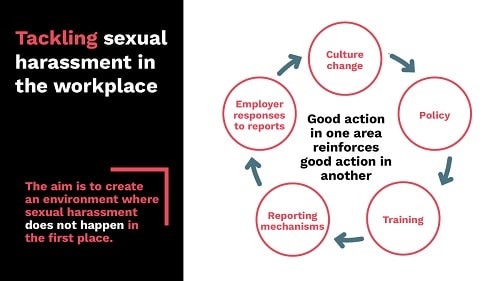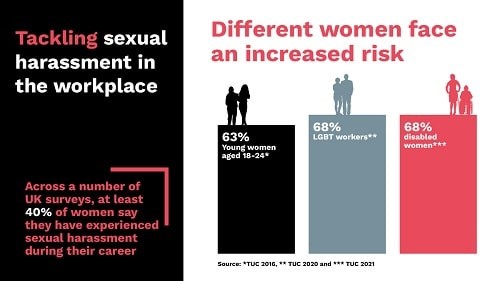Sexual harassment can have a devastating impact on an employee’s wellbeing, but it can only be prevented through proactive action and culture change by employers.
Features
Sexual harassment: time for action
July 2021, the UK government committed to bring in a regulatory duty on employers to prevent sexual harassment in the workplace. This significant change followed years of campaigning by the Fawcett Society, along with many others.
It moved the dial, acknowledging that sexual harassment at work isn’t a one-off, or something that happens on occasion by the aberrant actions of a few. Sexual harassment is a daily matter, hidden behind workplace cultures and practices that for too long have swept experiences under the carpet, leaving people (predominantly women), feeling intimidated, isolated and degraded.
 Photo: iStock credit- pic_studio
Photo: iStock credit- pic_studio
Many workplaces, whether intentionally or otherwise, have long upheld cultures that facilitate sexual harassment, whether by colleagues, superiors, clients or customers. Traditionally, employers seek to resolve these incidents discreetly, after they happen – with a lack of transparency, support mechanisms and inadequate training – to minimise liability.
This individualised approach often makes things worse for employees who do report – they not only re-live the trauma in reporting, but they can also experience victimisation and retaliation, for example, from the perpetrator, or from the organisation more broadly, such as being moved to a different department while the perpetrator is left in their existing role. So, the vicious cycle continues, with women – anyone can experience sexual harassment at work but women are disproportionally targeted – choosing not to take the risk of reporting and leaders remaining unaware of the scale of the problem.
For employers who want to create diverse, productive organisations, environments like this can be significantly damaging. Sexual harassment impacts financially in lost productivity and can reduce profits directly if employers have to pay employment tribunal fines and legal costs for failing to protect employees.
Employees who experience sexual harassment often have poorer mental and physical health and have an increased risk of experiencing post-traumatic stress disorder (PTSD). Being subjected to repeated, ‘low-level’ sexual harassment at work can produce cumulative impact that is equally stressful to that from rape or assault.
The lack of action by employers can cause further distress. Women report feeling let down by their employer – for example, due to their failure to discipline or dismiss the perpetrator, educate all staff and take action to prevent a reoccurrence. They often fear being in their workplace where the perpetrator continues to be employed.
There is strong evidence of a relationship between experiencing sexual harassment and lower job satisfaction, lower organisational commitment, job withdrawal and lower productivity. Managers in a recent Fawcett Society survey suggested that sexual harassment should be regularly discussed to signify the importance of tackling it and to counter the idea that it is rare and difficult to handle. They believed that by normalising the discussion of it, managers would understand that it is something that should be on their radar and that they should be equipped to handle.
At least 40 per cent of women experience sexual harassment during the course of their career, and women who are marginalised for other reasons, such as race or disability, face an increased risk and different forms of sexual harassment. In September 2021, the Fawcett Society, along with partners across the four nations of the UK – Chwarae Teg, Women’s Resource and Development Agency and Close the Gap – published the Tackling Sexual Harassment in the Workplace report, which draws together all this evidence, along with best practice for solutions. The report shows not only is this is a common, everyday matter, but also how to address it systematically and sensitively.
Now, with the upcoming regulatory duty that will require employers to take all the steps they can to prevent sexual harassment from colleagues, clients, customers and other people outside the organisation, is the perfect time to re-think how your organisation approaches the issue and take steps to create organisational cultures and norms that prevent it happening in the first place.
What is sexual harassment?
Workplace sexual harassment is unwanted behaviour of a sexual nature that has the purpose or effect of violating a worker’s dignity or creating an intimidating, hostile, degrading, humiliating or offensive environment. The person who reports it does not have to have been the target, nor do they ‘lose’ the ability to report if they did not object, nor if they ‘submitted’ to the harassment. What matters is the effect that the comment or action has on the recipient.
Sexual harassment is not only serious or physical incidents, it includes:
- Sexual comments, banter or jokes
- Staring or leering
- Questions about private or sex life or a person discussing their own sex life
- Spreading sexual rumours about a person
- Sending sexually explicit emails or text messages or contact on social media.
It is not always motivated by sexual interest; it can be used to humiliate or belittle people with the goal being to ‘put them in their place’, or to create entertainment for others. Legal protection from sexual harassment applies to almost everyone working for you: employees, interns and most freelancers.
Online working is not a protection, either, as the evidence shows it can create new opportunities for harassers and new kinds of private space where harassment may occur, such as social media. As the Fawcett Society report outlined:
- 45 per cent of women reported experiencing harassment online through sexual messages, cyber harassment and sexual calls
- Almost a quarter of women who had been sexually harassed said the harassment had increased or escalated since the start of the pandemic while they were working from home.
It’s also worth noting that proposed changes to legislation will broaden employers’ responsibility to protect their employees from harassment from third parties, such as clients, patients, customers, volunteers or third-party contractors.
 Alison Henderson, Policy and Research Manager at the Fawcett Society.
Alison Henderson, Policy and Research Manager at the Fawcett Society.
Tackling Sexual Harassment in the Workplace toolkit
The Fawcett Society and its partners have recently published the Tackling Sexual Harassment in the Workplace toolkit, which supports employers on how to implement the research findings to prevent sexual harassment in practice.
It covers the five pillars that need to be in place to change norms and prevent, not tolerate, sexual harassment. These are:
- Change your workplace culture
- Put in place a sexual harassment policy
- Train your employees
- Make it safe and easy for them to report
- Respond appropriately to employees’ reports.
It includes a checklist that outlines how you can start to put in place each of these elements in your workplace.
There is also a template climate survey designed to help an employer understand employees’ perceptions of the workplace culture and monitor the prevalence of sexual harassment. A survey is also a good opportunity to learn about the power imbalances and hierarchies that shape people’s experience in the workplace.
The toolkit also features an example anti-sexual harassment policy employers can use to develop their own policy, and training materials that can be adapted to suit the needs of each organisation. There are also template posters to help communicate the training on sexual harassment that is being offered to staff.
How can employers create a culture that does not tolerate sexual harassment?
Challenging the idea that sexual harassment is normal is a necessary and vital first step for any employer in preventing it. In organisations where sexual harassment is perceived to go unchecked by managers and bystanders, employees are unlikely to feel comfortable to report. Whereas if an employer takes sexual harassment seriously, employees are more likely to as well.
Be alert for how sexual harassment interacts with power in the workplace. Sexual harassment almost always involves a power imbalance, whether that is explicit (a senior person harassing a less senior or more precariously employed person), or implicit/cultural (a man harassing a woman). Employees often feel unable to report harassment by those more senior who could harm their career through victimisation. Retaliation or reprisals to the victim can be easy to deliver through organisational mechanisms like performance management or withholding of opportunities such as training or transfers.
How can employers create cultures that tackle sexual harassment?
- Improve diversity, equality and inclusion practices and diversity of staff, particularly at a senior level: evidence shows sexual harassment levels are higher in workplaces with more men. Set targets for the proportion of women – particularly women of colour, disabled women, and LGBTQ women – in senior leadership positions; and ensure hiring and promotion practices are unbiased to build diversity. Also ensure that leaders educate themselves about, for example, race, disability and gender barriers and experiences. Diverse and inclusive environments are ones where cultural values around gender and racial equality align with a climate where policies and practices do not disadvantage groups of people, thereby making them incompatible with sexually harassing behaviour.
- Demonstrate leadership commitment to tackling sexual harassment: leaders should state their commitment to eliminating it in the workplace and hold themselves and their peers to account.
- Demonstrate that any sexual harassment is unacceptable: employers should address every incident of sexual harassment, small and large, with seriousness and professionalism.
- Conduct a climate survey to measure attitudes to sexual harassment: ask employees anonymously about attitudes and sexual harassment in the workplace and use the findings to inform where action should be taken.

Implementing an anti-sexual harassment policy
A sexual harassment policy is a vital tool to outline how seriously your workplace takes sexual harassment.
Having a straightforward and concise policy that all staff are aware of is not only useful – for staff to use who have been sexually harassed or for managers who are handling a report of harassment – but is a clear indicator that your workplace takes sexual harassment seriously.
How can employers effectively implement a policy on tackling sexual harassment?
- Publish a standalone sexual harassment policy covering all nine essential elements: involve employees in its development, and make it accessible for all, including by using simple and easy to understand words and concepts, and with accessible versions.
- Communicate the policy to employees and regularly advertise it: senior leaders should share it with all employees, outlining its contents and importance. New employees should be introduced to the policy during their induction.
- Follow through on the policy statement: this means appropriately and proportionally disciplining anyone who is found to have committed sexual harassment, including behaviours that may have in the past been treated as ‘normal’.
Consistently training employees
Embedding consistent and tailored anti-sexual harassment training is an important mechanism in both helping to prevent sexual harassment in the first place and as part of employer efforts to change the workplace culture around what is unacceptable behaviour.
Training should be tailored to the organisation’s individual needs, using information gathered from previous reports and from the climate survey to understand experiences, challenges and who could be either subject to sexual harassment or a potential perpetrator of it.
How can employers run effective anti-sexual harassment training?
- Train all employees, providing both sexual harassment and bystander training: all employees should be regularly trained in definitions of sexual harassment (such as the forms it may take, such as office ‘banter’ or intrusive questions), who is targeted and by whom, the harm it can cause, how to report it, and the importance of preventing it. Training should also cover intersectional types of sexual harassment – how somebody’s multiple characteristics and identities, such as their gender, race, sexual orientation, religion and disability, can interact to create a unique experience of disadvantage or inequality. Bystander training teaches staff how to act if they witness sexual harassment, particularly if the observed harasser is someone more senior.
- Provide role-specific training for managers and investigators: managers and investigators should also receive training in how to support the employee who made a report, the processes to follow, how to prevent or address victimisation of the employee who made the report, and who to go to if they need support themselves.
- Evaluate the training: keep in mind that positive outcomes (i.e. a reduction in sexual harassment rates) may only be apparent in the long term. Employers should adapt the training based on employee feedback and suggestions.
Making it safe and easy for employees to report sexual harassment
A robust reporting system allows employees to firstly, know how to make a report, and secondly, feel safe to do so. By having multiple reporting routes, employees can report in a way that works for them – especially to someone who is not their manager, as that person can often be the harasser.
A key reason for not reporting is that the employee being harassed is less senior than their harasser, or facing additional barriers in the workplace (for example, they are a new recruit, young, disabled, a person of colour or a freelancer). These workers may rightly fear the consequences a more senior person has the power to bring about, whether to their career or to personal reputation from rumours if there is not absolute confidentiality about their report.
Making employees feel safe to report and that they will be believed and action will be taken if they do will help to increase reporting and allow the organisation to effectively tackle sexual harassment.
How can employers make it safe and straightforward to report?
- Allow employees to make an informal or formal report and make them aware of the difference: allow staff to make an informal report, with the option of making a formal report later, as this will help some to come forward.
- Offer multiple reporting routes: this can include a phone line, a webform or app, an independent third-party and an anti-sexual harassment specialist. At a minimum, staff should be able to make a report to at least two different people and those people should come from different levels within the organisation.
Responding to employees with respect and empathy
The belief that an organisation is challenging sexual harassment and changing its culture will be broken irreparably if action does not follow words – reports of sexual harassment must be taken seriously. Victimisation – despite being unlawful – is a key risk if the identity of the employee who reported is not kept confidential.
Effectively handling sexual harassment complaints is fundamental because it indicates the employer is serious about tackling sexual harassment. It can also mitigate the impact of experiencing sexual harassment both on employees and on employers, as emotional distress is decreased and employees are more likely to want to stay in their jobs.
Managers surveyed for the Fawcett Society report described being frustrated that reports of sexual harassment are sometimes brushed aside in their organisation. They want help to do this better, with good systems for handling reports of sexual harassment, and someone to go to for support or to make sense of guidance.

How can employers respond with respect and empathy?
- Listen respectfully and without judgement: recognise that the experience may have
been traumatic; and thank the person for coming forward. - Provide information about next steps and ask the employee who made the report what they would like to do: if the employee who made the report works with the alleged harasser, the alleged harasser should be reassigned or suspended while the investigation is ongoing (not the person reporting it).
- Keep the report confidential: only members of staff who absolutely must know about the report should be informed. This is vital to stop victimisation. Colleagues may ‘cold-shoulder’ or mistreat a person who they think was ‘responsible’ for another colleague getting in trouble.
- Recognise that incidents may involve both sexual harassment and racial harassment, or other forms of discrimination: for example, including women of colour, LGBTQ+ people, disabled women and religious minorities. Risk management can help you consider other factors that may increase the likelihood of sexual harassment, such as young employees or interns, or working solo with third parties such as clients or customers.
Finally, being transparent about your investigations of sexual harassment is vital. Regularly publish data on how many reports of sexual harassment have been received, how many were investigated and the outcomes of the investigation, giving employees confidence that you are working to prevent it in future.
If you’re an organisation that wants to create a workplace culture that does not tolerate sexual harassment, you can download the Tackling Sexual Harassment in the Workplace toolkit.
Advice in this article is taken from the Tackling Sexual Harassment in the Workplace report.
Tackling Sexual Harassment in the Workplace is a project led by the Fawcett Society and partners Chwarae Teg, Women’s Resource and Development Agency, and Close the Gap. It is funded by TIME’S UP UK Justice and Equality Fund, managed by Rosa.
Alison Henderson is Policy and Research Manager at the Fawcett Society.
FEATURES

Sedentary working and how to combat the ‘sitting disease’
By Gavin Bradley, Active Working on 05 April 2024
Prolonged and excessive sitting poses a major risk to our health, but the Get Britain Standing campaign and On Your Feet Britain Day on 25 April are a great way of encouraging workers to sit less and move more.

Company culture and wellbeing: a crucial link
By Bex Moorhouse, Invigorate Spaces on 05 April 2024
Investing in measures to support worker wellbeing will be ineffective unless the company culture genuinely incorporates values like teamwork, involvement, flexibility and innovation.

Office design and culture: happier and healthier staff – or the opposite?
By Guy Osmond, Osmond Ergonomics on 03 April 2024
Applying ergonomic principles to workstation set-ups and ensuring the physical environment supports neurodivergent people are just some of the ways of creating an office where everyone can thrive, but a supportive and positive organisational culture is vital too.


